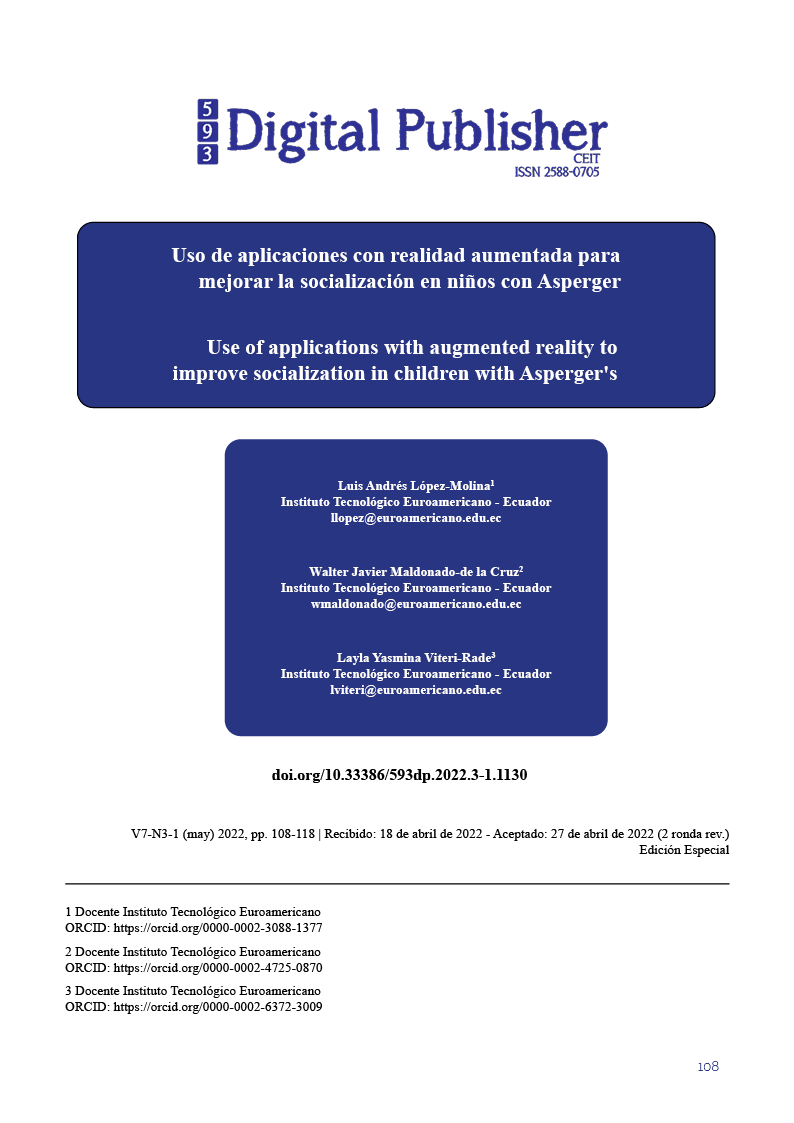Use of applications with augmented reality to improve socialization in children with Asperger's
Main Article Content
Abstract
The objective of this research was based on analyzing the use of applications with augmented reality to improve socialization in children with Asperger's, and to understand the benefits, advantages or disadvantages that the use of this technology can cause in the development of children who present this syndrome belonging to ASD. To carry out this research, a literature review was carried out through a documentary-type bibliographic design. There are various applications and AR video games suitable and adapted to be used by children with Asperger syndrome, which allows them to develop communication skills with their peers, and their families, in a way that will allow them to have a calmer development and adulthood where they can be able to achieve a life and social interaction with their peers with less fear, reducing their anxiety episodes due to their lack of security when feeling that some situation is out of their area of control. It is important to consider that these AR applications must always be used under medical surveillance to control and verify the progress that children may have while using this equipment.
Downloads
Article Details

This work is licensed under a Creative Commons Attribution-NonCommercial-ShareAlike 4.0 International License.
1. Derechos de autor
Las obras que se publican en 593 Digital Publisher CEIT están sujetas a los siguientes términos:
1.1. 593 Digital Publisher CEIT, conserva los derechos patrimoniales (copyright) de las obras publicadas, favorece y permite la reutilización de las mismas bajo la licencia Licencia Creative Commons 4.0 de Reconocimiento-NoComercial-CompartirIgual 4.0, por lo cual se pueden copiar, usar, difundir, transmitir y exponer públicamente, siempre que:
1.1.a. Se cite la autoría y fuente original de su publicación (revista, editorial, URL).
1.1.b. No se usen para fines comerciales u onerosos.
1.1.c. Se mencione la existencia y especificaciones de esta licencia de uso.
References
Alqahtani, A., Jaafar, N., & Alfadda, N. (2011). Interactive speech based games for autistic children with Asperger Syndrome. in Proceedings of the 2011 International Conference and Workshop on the Current Trends in Information Technology, 11. doi:doi: 10.1109/CTIT.2011.6107947.
Arroyave, M., Castillo, L., & Isaza, G. (2018). Analisis de la interacción social en patologías mentales por medios computacionales: caso de estudio asperger y tastorno por déficit de atención. Información Tecnológica, 29(2), 63-72. doi:http://dx.doi.org/10.4067/S0718-07642018000200063
Bian, D., Wade, J., Swanson, A., Weitlauf, A., & Warren, a. N. (2019). Design of a Physiology-based Adaptive Virtual Reality Driving Platform for Individuals with ASD. ACM Transactions on Accessible Computing, 12(1), 2-24. doi:https://doi.org/10.1145/3301498
Bonete, S., Calero, M., & Fernández, A. (2014). Group training in interpersonal problem-solving skills for workplace adaptation of adolescents and adults with Asperger syndrome. SAGE, 19(4), 409–420. doi:https://doi.org/10.1177/1362361314522354
Borja, L., Chocarro, E., Busto, J., & López, J. (2018). Aportaciones de la Realidad aumentada en la inclusión en el aula de estudiantes con trastorno del espectro autista. edmetic. Revista de Educación Mediática y TIC, 7(2), 120-134. doi:https://doi.org/10.21071/edmetic.v7i2.10134
Centro Universitario de Tecnología y Arte Digital, U-Tad. (2020). CicerOn VR: Virtual Speech Coach. Memoria Final Proyecto CicerOn VR: Virtual Speech Coach. Obtenido de https://www.tecnologiasaccesibles.com/sites/tecnologiasaccesibles/files/Descargas/MemoriaFinal_CicerOn.pdf
Delgado, J., & Duchi, D. (2021). Desarrollo de una interfaz humano-computador mediante la animación de avatares generados a partir de fotogramtería. Proyecto Técnico con enfoque investigativo, Universidad Politécnica Salesiana , Cuenca. Obtenido de http://dspace.ups.edu.ec/handle/123456789/21214
Domínguez, A. (2019). Diseño de videojuegos como terapia de juego para niños con Asperger. Cuaderno del Centro de Estudios en Diseño y Comunicación. Obtenido de https://dialnet.unirioja.es/servlet/articulo?codigo=8279076
Dube, W. F., Mueller, M., Grant, E., Lorin, L., & Deutsch, C. (MAYO de 2016). Stimulus Overselectivity in Autism, Down Syndrome, and Typical Development. American Journal on Intellectual and developmental Disabilities, 121(3), 219–235. doi:https://doi.org/10.1352/1944-7558-121.3.219
Fage, C., Consel, C., Balland, E., Etchegoyhen, K., Amestoy, A., Bouvard, M., & Sauzéon, H. (2018). Tablet Apps to Support First School Inclusion of Children With Autism Spectrum Disorders (ASD) in Mainstream Classrooms: A Pilot Study. Frontiers in Psychology. Educational Psychology, 9(2018), 20-100. doi: https://doi.org/10.3389/fpsyg.2018.02020
Fridhi, A., Benzarti, F., Frihida, A., & Amiri, H. (2018). Application of Virtual Reality and Augmented Reality in Psychiatry and Neuropsychology, in Particular in the Case of Autistic Spectrum Disorder (ASD). (Neurophysiology, Ed.) Neurophysiology, 50(3), 222-228. doi:10.1007/s11062-018-9741-3
Gilabert-Cerdá, A., & Lorenzo-Lledó, A. (2021). Análisis de aplicaciones de realidad aumentada para la práctica de futuros docentes con alumnado que presenta Trastorno del Espectro Autista. RIDU, Revista d’Innovació Docent Universitària(13), 18-27. doi:http://dx.doi.org/10.1344/RIDU2021.13.3
Heimann, M., Nelson, K., Tjus, T., & Gillberg, C. (1995). Increasing reading and communication skills in children with autism through an interactive multimedia computer program. Journal of Autism and Developmental Disorders(25), 459-480. doi:https://doi.org/10.1007/BF02178294
Howlin, P. (1998). Practitioner Review: Psychological and Educational Treatments for Autism. The Journal of Child Psychology and Psychiatry and Allied Disciplines, 39(3), 307-322. doi:https://doi.org/10.1017/S0021963097002138
Instituto Nacional de la Salud Mental, INSM. (2022). Trastornos del Espectro Autista. Recuperado el 09 de Mayo de 2022, de https://www.nimh.nih.gov/sites/default/files/documents/health/publications/espanol/trastornos-del-espectro-autista/19-mh-8084s-autismspecdisdr-sp.pdf
Parsons, S., Beardon, L., Neale, H., Reynard, G., Eastgate, R., Wilson, J., Hopkins, E. (2000). Development of social skills amongst adults with Asperger’s Syndrome using virtual environments: the’AS Interactive’project. The 3rd International Conference on Disability, Virtual Reality and Associated Technologies, ICDVRAT, (págs. 23-25). Obtenido de http://playpen.icomtek.csir.co.za/~acdc/assistive%20devices/Artabilitation2008/archive/2000/papers/2000_22.pdf
Pensosi, V., & Villamía, B. (2012). Proyectos de la Fundación Orange a favor de las personas con barreras de comunicación. Repositorio Universidade da Coruña. Obtenido de http://hdl.handle.net/2183/13211
Pichot, P., López-Ibor, J., & Valdés, M. (1995). DSM-IV. Manual diagnóstico y estadístico de los trastornos mentales (Cuarta Edición ed.). (H. B. Sa, Ed.) Barcelona: MASSON, S.A. Obtenido de https://www.eafit.edu.co/ninos/reddelaspreguntas/Documents/dsm-iv-manual-diagnostico-estadistico-trastornos-mentales.pdf
Schery, T., & O´Connor, L. (2002). Language intervention: Computer training for young children with special needs. British Journal od Educational Technology, 28(4), 271-279. doi:https://doi.org/10.1111/1467-8535.00034
Volkmar, M. R., & Woodbury-Smith, F. (2009). Asperger syndrome. Eur Child Adolesc Psychiatry, 18, 2–11. doi:10.1007/s00787-008-0701-0.

